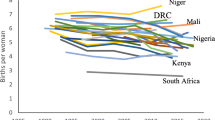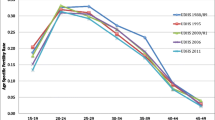Abstract
Ghana’s current population is about 24.2 million, and given the current population growth rate of 2.4 %, Ghana’s population is expected to double in about 29 years. Although fertility rates in Ghana have declined from 6.4 to 4 children per woman between 1988 and 2008, this transition has not been homogenous across all regions of Ghana. Fertility rates remain higher in the northern regions of the country, compared to the southern regions. This paper examines explanations for the regional fertility variations—particularly the persistently high fertility rates observed in the northern regions—paying particular attention to the contribution of socioeconomic, cultural and religious factors, and fertility attitudes among women in explaining this phenomenon. In order to capture the most recent fertility variations in the country, the paper uses the most recent round (2008) of the Ghana Demographic and Health Survey, and employs a Poisson multivariate estimation technique. Results indicate that regional differences in fertility are largely explained by socioeconomic factors such as urbanization, child mortality, education and household wealth. Cultural and religious factors also explain some of the observed variation between the northern region and the southern regions. The inclusion of the duration of post-partum amenorrhea and other proximate determinants in the model specifications significantly explains residual differences in fertility outcomes, particularly among the three northern regions. Findings therefore indicate a need for more region-specific policy targeting in the effort to reduce high fertility rates and ease the growth in population.




Similar content being viewed by others
Notes
Figures for the three northern regions for 1988 are not available the three regions were aggregated in that year and a single TFR statistic (6.8 children per woman) was generated. This statistic is close to the 6.9 estimate for Brong-Ahafo, the region with the highest TFR rate for that year.
References
Agyei-Mensah, S. (2006). Fertility transition in Ghana: Looking back and looking forward. Population, Space and Place, 12, 461–477.
Appiah-Yeboah, S., Jackson, E. F., Phillips, J. F., Akweongo, P. (2001). The impact of agricultural adversity on fertility among the kassena-nankana of northern Ghana. Paper presented at the 2001 Annual Meeting of the Population Association of America, Washington, DC, 29–31 March.
Badasu, D. (2003). Policy implications of the variations in Ghana’s fertility transition. Research Review, 19(1), 1–13.
Bledsoe, C., Hill, A., D’Alessandro, U., & Langerock, P. (1994). Constructing natural fertility: The use of western contraceptive technologies in rural Gambia. Population and Development Review, 20(1), 81–113.
Bongaarts, J. (2008). Fertility transitions in developing countries: Progress or stagnation? Studies in Family Planning, 39(2), 105–110.
Bongaarts, J., & Casterline, J. (2012). Fertility transition: Is sub-saharan Africa different? Population and Development Review, 38, 153–168.
Bongaarts, J., & Watkins, S. C. (1996). Social interactions and contemporary fertility transitions. Population and Development Review, 22, 639–682.
Casterline, J. (2001). Diffusion processes and fertility transition: Introduction. Diffusion processes and fertility transition: Selected perspectives, Committee on Population, National Resource Council.
Casterline, J., & Agyei-Mensah, S. (2014). Fertility desires and fertility decline in sub-Saharan Africa. In A. Mturi & S. Agyei-Mensah (Eds.), Explaining fertility differences in sub-Saharan Africa: Projecting the demographic future. Lewiston, NewYork: The Edwin Mellen Press.
Chuks, J. (2003). Ghana’s reproductive revolution: Analysis of the determinants of fertility transition. African Population Studies, 17(1), 47–67.
Cleland, J., Ndugwa, R. P., & Zulu, E. M. (2011). Family planning in sub-Saharan Africa: Progress or stagnation? Bulletin of the World Health Organization, 89(2), 137–143.
Cleland, J., Phillips, J., Amin, S., & Kamal, G. (1994). The determinants of reproductive change in Bangladesh: Success in a challenging environment. Washington DC: The World Bank, Regional and Sectoral Studies.
Das Gupta, M., Bongaarts, J., & Cleland, J. (2011). Population, poverty, and sustainable development: A review of the evidence. Washington DC: World Bank Policy Research Working Paper # 5719.
Ezeh, A. C., Mberu, B. U., & Emina, J. O. (2009). Stall in fertility decline in eastern African countries: Regional analysis of patterns, determinants and implications. Philosophical Transactions of the Royal Society Biological Sciences, 364, 2991–3007.
Gaisie, S. K. (1981). Child-spacing patterns and fertility differentials in Ghana. In H. Page & R. Lesthaeghe (Eds.), Child spacing in tropical Africa: Traditions and change (pp. 237–253). London: Academic Press.
Garenne, M. (2008). Fertility change in sub-Saharan Africa, DHS comparative reports, no. 18. Calverton, MD: Macro International Inc.
Ghana Population Stabilization Report. (2011). National Population Council. http://www.populationcommunication.com/Medias/Ghana_report.pdf. Accessed 13 Nov 2014.
Ghana Demographic and Health Survey. (2003). Population of Ghana: Regional trends: Factsheet, National Population Council.
Ghana Statistical Service. (2012). Ghana 2010 population and housing census, report of final results.
Ghana Statistical Service (GSS), Ghana Health Service (GHS), and ICF Macro. (2009). Ghana demographic and health survey 2008: Key findings. Maryland, USA: Calverton.
Knodel, J., & Van de Walle, E. (1986). Lessons from the past: Policy implications of historical fertilitystudies. In A. J. Coale & S. C. Watkins (Eds.), The decline of fertility in Europe (pp. 390–419). Princeton: Princeton University Press.
Livi-Bacci, M. (1992). A concise history of world population. Cambridge, Mass: Blackwell.
Malmberg, B. (2008). Demography and the development potential of sub-Saharan Africa (p. 34). Stockholm: Department of Human Geography, Stockholm University.
Mason, K. O. (1997). Gender and demographic change: What do we know? In G. W. Jones et al. (Eds.), The continuing demographic transition (pp. 158–182). Oxford: Clarendon Press.
Mberu, B. U., & Reed, H. E. (2014). Understanding sub-group fertility differentials in Nigeria. Population Review, 53(2), 23–46.
Moultrie, T. A., Hosegood, V., McGrath, N., Hill, C., Herbst, K., & Newell, M. L. (2008). Refining the criteria for stalled fertility declines: An application to rural KwaZulu-Natal, South Africa, 1990–2005. Studies in Family Planning, 39(1), 39–48.
Odimegwu, C., & Kekovole, J. (Eds.). (2014). Continuity and change in Sub-Saharan African demography. New York: Routledge.
Phillips, J., Bawah, A., & Binka, F. (2005). Accelerating reproductive and child health program development: The Navrongo initiative in Ghana. Population Research Division, Working Paper, No. 208.
Pritchett, L. H. (1994). Desired fertility and the impact of population policies. Population and Development Review, 20(1), 1–55.
Reed, H. E., & Mberu, B. U. (2014). Capitalizing on Nigeria’s demographic dividend: Reaping the benefits and diminishing the burdens. African Population Studies, 27(2), 319–330.
Shapiro, D., & Gebreselassie, T. (2008). Fertility transition in sub-Saharan Africa: Falling and stalling. African Population Studies, 23(1), 3–23.
Westoff, C.F., & Ochoa, L. H. (1991). Unmet need and the demand for family planning. DHS comparative studies, no. 5. Columbia, MD: DHS-IRD/Macro.
Acknowledgments
We wish to thank John Casterline for his preliminary review of this paper. An earlier version of this paper was presented at the University of Ghana, Economics Department Seminar Series. We are grateful to the participants of the seminar for their feedback. The usual disclaimer applies.
Author information
Authors and Affiliations
Corresponding author
Ethics declarations
Conflict of interest
None.
Rights and permissions
About this article
Cite this article
Agyei-Mensah, S., Owoo, N.S. Explaining regional fertility variations in Ghana. J Pop Research 32, 157–172 (2015). https://doi.org/10.1007/s12546-015-9147-7
Published:
Issue Date:
DOI: https://doi.org/10.1007/s12546-015-9147-7




